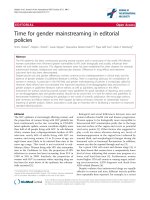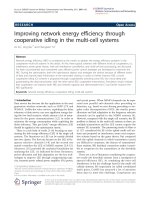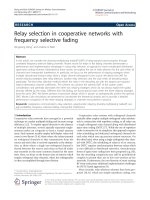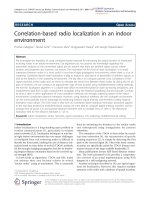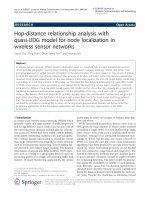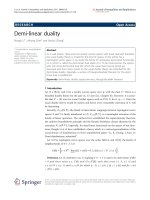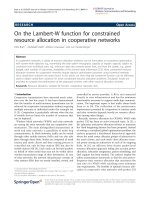Báo cáo hóa học: " Editorial Cooperative Localization in Wireless Ad Hoc and Sensor Networks" pdf
Bạn đang xem bản rút gọn của tài liệu. Xem và tải ngay bản đầy đủ của tài liệu tại đây (425.05 KB, 2 trang )
Hindawi Publishing Corporation
EURASIP Journal on Advances in Signal Processing
Volume 2008, Article ID 353289, 2 pages
doi:10.1155/2008/353289
Editorial
Cooperative Localization in Wireless Ad Hoc
and Sensor Networks
Davide Dardari,
1
Chia-Chin Chong,
2
Damien B. Jourdan,
3
and Lorenzo Mucchi
4
1
Wireless Communication Laboratory, Depart ment of Electronics, Computer Sciences and Systems,
University of Bologna, 40126 Bologna, Italy
2
DoCoMo Communications Laboratories USA, Inc., Palo Alto, CA 94303, USA
3
Rockwell Collins, Warrenton, VA 20187, USA
4
Department of Electronics and Telecommunications, University of Florence, 50139 Florence, Italy
Correspondence should be addressed to Davide Dardari,
Received 19 June 2008; Accepted 19 June 2008
Copyright © 2008 Davide Dardari et al. This is an open access article distributed under the Creative Commons Attribution
License, which permits unrestricted use, distribution, and reproduction in any medium, provided the original work is properly
cited.
The need for highly accurate position information is of great
importance in many commercial, public safety, and military
applications. With the integration of GPS into cell phones, in
conjunction with WiFi localization, we are entering a new era
of ubiquitous location-awareness. In the coming years, we
will see the emergence of high-definition location-awareness
applications: localization systems that operate in the harsh
communication environments where GPS does not operate,
such as inside buildings and in caves, still providing submeter
localization accuracy which is not currently feasible with
GPS.
Reliable localization in such conditions is a key enabler
for a wide variety of applications including logistics, security
tracking (the localization of authorized persons in high-
security areas), medical applications (the monitoring of
patients), search and rescue (communications with fire fight-
ers or natural disaster victims), control of home appliances,
automotive safety, and military systems, as well as in the large
set of emerging wireless sensor network (WSN) applications.
Other nonconventional applications of location information
include networking protocols that take advantage of posi-
tion information to improve the performance of routing
algorithms (georouting), as well as enabling interference
avoidance techniques in future cognitive radios.
One of the major requirements for most applications
basedonwirelessadhocandsensornetworksisaccurate
node localization even in the absence of infr a structure
(anchor nodes). In fact, sensed data without position
information is often less useful. Due to several factors (e.g.,
cost, size, power) only a small fraction of nodes obtain the
position information of the anchor nodes. In this case, a node
has to estimate its position without a direct interaction with
anchor nodes; and a cooperation b etween nodes is needed in
a multihop fashion. In some applications none of the nodes is
aware of its absolute position (anchor-free) and only relative
coordinates are estimated instead.
Whether the localization techniques are based on signal
strength or on signal time-of-flight, measurement errors are
unavoidable, especially in cluttered environments. Robust
estimation signal processing schemes as well as cooperative
localization algorithms are useful to improve localization
accuracy.
The goal of this special issue is to bring together
contributions from signal processing, communications, and
related communities, with particular focus on fundamental
limitations, signal processing, and new algorithm design
methodologies of cooperative localization systems.
The understanding of fundamental localization perfor-
mance limits in cooperative networks in the presence of
unreliable measurements is of great importance since the
knowledge of such limits can also help the design and
comparison of new localization algorithms. This topic is
covered in the first paper “Cooperative localization bounds
for indoor ultra-wideband wireless sensor networks” by N.
Alsindi and K. Pahlavan where, based on empirical models of
ultra-wideband width (UWB) time-of-arrival- (TOA-) based
outdoor-to-indoor and indoor-to-indoor ranging, it pro-
vides cooperative localization bounds for WSNs in different
indoor multipath environments: residential, manufacturing
floor, old office, and modern office buildings.
2 EURASIP Journal on Advances in Signal Processing
WSNs usually have to deal with limited energy and
hardware resources. The paper “A wireless sensor network
for RF-based indoor localization” by V. A. Kaseva et al.
proposes a novel MAC protocol for location tracking using
low complexity nodes where energy-efficiency and scalability
are a primar y concern. Experimental results on commercial
devices validate the solution proposed.
The pap er “Error control in distributed node self-
localization” by J. Liu and Y. Zang characterizes the effect
of error propagation in distributed localization algorithms.
Further, a suitable mechanism to mitigate such errors is
proposed and applied to existing localization algorithms.
In the paper “A new time-based algorithm for positioning
mobile terminals in wireless networks” by I. Martin-Escalona
and F. Barcelo-Arroyo, a hybrid localization technique is
proposed. The positioning algorithm, named time of arrival
to time difference of arrival (TOAD), computes TDOA
measurements from the messages that TOA-base ranging in
sight stations exchange while their positioning processes are
running. This study addresses the accuracy of the TOAD
algorithm in two different environments: line-of-sight (LOS)
and non-line-of-sight (NLOS). This technique improves the
scalability and integrity of TOA techniques, making possible
for the stations to position themselves without injecting
network traffic.
UWB is a promising technology for accurate localization
in harsh environments and it is specifically addressed in the
following two papers.
The first paper “Two-step time of arrival estimation for
pulse-based ultra-wideband systems” by S. Gezici et al. treats
the problem of detection and TOA estimation of the first
path using UWB signal. In order to accomplish both accurate
TOA estimation and to reduce the estimation time, a two-
step algorithm is proposed where first a coarse TOA estimate
is obtained starting from received signal energy samples,
then the arrival time of the first signal path is refined by
considering a hypothesis testing approach.
In “The effect of cooperation on localization systems
using UWB experimental data” by D. Dardari et al., an
extensive measurement campaign is described and the
measured data are used to derive statistical ranging models
based on TOA estimation in the presence of LOS and NLOS
propagation conditions. In addition, an iterative cooperative
localization algorithm is proposed. Starting from measured
data, the effect of the cooperation between target nodes is
investigated.
The last two papers address the problem of localizing
and tracking objects using a WSN. In particular, the paper
“Localization capability of cooperative anti-intruder radar
systems” by E. Paolini et al. considers the problem of
localizing passive objects with a multistatic radar using
impulse radio UWB technology. The proposed system
consists of a cooperative network of one transmitting UWB
node and at least three receiving nodes. The analysis begins
by considering a single pair of one transmitter and one
receiver. Given the transmission power and the ability of
the receiver to resolve the UWB signal, the region where the
target can be detected is obtained, along with the associated
localization error. The impact of node location, transmitted
power, and localization uncertainty are then discussed for the
complete multistatic system. Given these conflicting factors,
a criterion is suggested for effectively placing the transmitter
and receiver nodes.
Finally, the last paper “Tracking objects with networked
scattered directional sensors” by K. H. Plarre and P. R. Kumar
proposes a three-phase optimization strategy for tracking
multiple objects using a network of directional sensors. The
objects to be tracked are assumed to be moving in straight
lines and at constant speed as they cross the region. The
sensors envisioned in this application have a very narrow
field of view, such as lasers or highly directional temperature
sensors. As the object crosses a sensor’s line of sight, only
the time of the detection is recorder; neither range nor angle
measurements are necessary. T he task of the sensors is then
to estimate the directions and speeds of the objects and the
sensor lines, which are unknown a priori. This estimation
problem involves the minimization of a highly nonconvex
cost function, and is solved using the proposed adaptive basis
algorithm.
ACKNOWLEDGMENTS
Several researchers worldwide have contributed to this
special issue submitting their latest research. The authors
would like to thank all the reviewers for their great effort in
suggesting improvements during successive iterations. They
would like also to send their special thanks to the publisher,
its staff, and the Editor-in-Chief for their patience and useful
suggestions during the finalization of this issue. They hope
that this special issue will represent a useful starting point
and stimulus for further research on wireless localization
technologies in the coming years.
Davide Dardari
Chia-Chin Chong
Damien B. Jourdan
Lorenzo Mucchi


